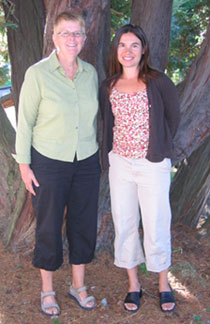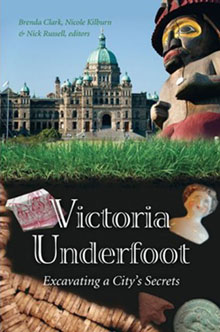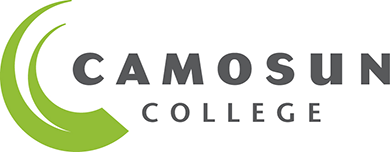Solving mysteries from the ground up
Archived Content
This archived web page remains online for reference, research or record-keeping purposes. This page will not be altered or updated and may contain out of date information. If you’re looking for specific information and haven’t found it, please contact communications@camosun.ca.
 |
| Brenda Clark and Nicole Kilburn, Camosun Anthropology instructors |
“Victoria’s past will be exposed as a whole new cityscape,” says Nicole Kilburn, Anthropology instructor at Camosun. She and Brenda Clark, also an instructor with Anthropology, co-authoured a chapter and are editors of the book Victoria Underfoot: Excavating a City’s Secrets—due out from Harbour Publishing this fall.
A whole different view
Clues to the past are exposed through a variety of sources. Alongside oral history, photographs and written documents, is the art of archaeology. Over time, people imprint their landscape with who they are and what they do, and archaeology excavates these secrets.
Victoria is traditionally viewed as a colonial landscape. “This book will offer a bit of an eye-opener,” says Kilburn. Joined by third editor, Nick Russell, president of Victoria’s Hallmark Society, Kilburn and Clark gathered a unique collection of archaeological essays and photographs by a variety of authours, each unearthing a different view of Victoria’s prehistory and history.
What is underneath Victoria?
Each chapter explains a differing technique or approach used in connecting underground discoveries of past Victoria to present-day Victoria.
The chapter by Kilburn and Clark investigates the cultural landscape of Lekwungen (Songhees) peoples and their ancestors, who lived in the greater Victoria area for millennia prior to the arrival of Europeans. Specifically, they investigate how archaeological findings can grow in significance when partnered with knowledge held by modern populations. Human remains and artifacts uncovered by a condominium development in Oak Bay opened a door to dialogue with the Songhees community and this increased both the interpretive value of the findings as well as helped foster Songhees self-determination.
 Victoria Underfoot also explains local mysteries. For example, the purple prisms dotted into the sidewalk of Broughton Street were originally inserted to offer daylight to basements and gradually tinged purple due the aging process of manganese. There is a discussion of how archaeological discoveries can result from new technology—ground-penetrating radar is used to locate unmarked graves in Victoria’s Pioneer Cemetery. The role of the provincial heritage legislation is outlined and its need to find a balance in protecting our rich cultural heritage in a society dependant on development. Artifacts recovered from historic Chinatown paint a picture of early immigrant Chinese life in the growing colonial city. The prehistory and history of the Gorge is pieced together by investigating the array of artifacts casually lifted from the muddy banks of the waterway, and the difficulty in interpreting artifacts claimed from decades of looting is discussed.
Victoria Underfoot also explains local mysteries. For example, the purple prisms dotted into the sidewalk of Broughton Street were originally inserted to offer daylight to basements and gradually tinged purple due the aging process of manganese. There is a discussion of how archaeological discoveries can result from new technology—ground-penetrating radar is used to locate unmarked graves in Victoria’s Pioneer Cemetery. The role of the provincial heritage legislation is outlined and its need to find a balance in protecting our rich cultural heritage in a society dependant on development. Artifacts recovered from historic Chinatown paint a picture of early immigrant Chinese life in the growing colonial city. The prehistory and history of the Gorge is pieced together by investigating the array of artifacts casually lifted from the muddy banks of the waterway, and the difficulty in interpreting artifacts claimed from decades of looting is discussed.
The concept that different areas of Victoria have had different significance to different groups of people is examined. For instance, Rodd Hill to the west of Victoria, is the site of burial cairns for pre-contact peoples, however, colonial populations primarily viewed these rocky bluffs as a fort for military defence.
Ancient dumps offer archaeologists great repositories of past cultural activities. The results of a wet site excavation on the Esquimalt Lagoon that was discovered while digging trenches for a sewer, and uncovering elements of life from 3,400 years ago is summarized. Another chapter looks at when the Royal Jubilee Hospital dump was excavated, the resulting artifacts combined with archival evidence to piece together the workings of a hospital from the 1890s.
Stewards of our own heritage—the Camosun connection
The book celebrates digging up our own past, rather than digging up the past of another culture, and in doing so, promotes the need to be stewards of own our heritage.
“At Camosun, we promote the relevance of archaeology by bringing the community to the college and the college to the community,” says Kilburn. A goal of the college is to raise awareness about local archaeological and heritage resources and form partnerships with local First Nations. This is demonstrated in events such as the Camas harvest and pit-cook, recently co-hosted with the Songhees Land Management Department and held in a Lansdowne campus Garry oak meadow.
The recently-developed Archaeological Field Assistant program is an 80-hour certificate and offers a tremendous opportunity for students to work with real artifacts as well as guest speakers from local First Nations communities.
For more information on anthropology courses and career options through Camosun, contact Paul Brady, Anthropology Chair at 250–370–3288 or brady@camosun.bc.ca.
To meet the editors, Kilburn, Clark and Russell, and taker a closer view of Victoria Underfoot, come to the book-signing event at Munro’s Books, 1108 Government Street, from 2pm to 3pm on October 4.
Last updated: September 29, 2008 3:21 pm


